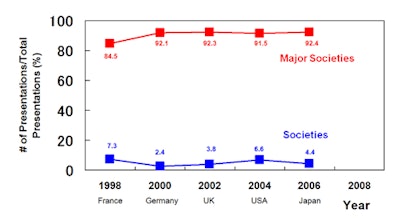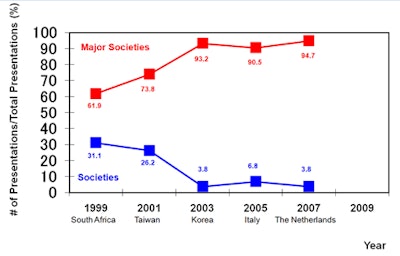Gavin Greenoak, vice-president, IFSCC
Xavier Romeu, president, IFSCC
Johann W. Wiechers, immediate past president, IFSCC
Amy Wyatt, chair of the education committee , IFSCC
Fujihiro Kanda, chair of the science committee of the IFSCC
The International Federation of the Societies of Cosmetic Chemists (IFSCC), Luton, United Kingdom
The International Federation of the Societies of Cosmetic Chemists (IFSCC) will celebrate its 50th anniversary next year in Melbourne, Australia, during the 2009 IFSCC Conference—a true milestone in the history of the IFSCC! However, as an organization of and for cosmetic chemists, the IFSCC has changed over the years. In fact, the purpose of this article is to inform readers about the latest changes that were agreed upon in Barcelona in 2008 during the 25th IFSCC Congress.
These changes relate to three things: adopting a program that differentiates between IFSCC Conferences and Congresses; implementing a prestigious new educational program—the Ecatarina Merica Cosmetic Education Programme; and finally, organizing the next IFSCC Conference to be held back-to-back with the in-cosmetics Asia show, to be held in Singapore the week after the IFSCC in Melbourne.
These three initiatives are the IFSCC's attempts to get closer to its members. After all, the IFSCC should be a part of every cosmetic scientist's life and not just a part of the more experienced members'. The present article explains the rationale behind these initiatives, of course in an attempt to drum up participation.
Differentiating Congresses and Conferences
In the past, IFSCC Congresses have occurred every even-numbered year, and IFSCC Conferences every odd-numbered year. The former typically attracts more than 1,000 individuals, whereas the latter is visited by approximately 450 visitors. The Congresses last three days whereas the Conferences last two days. Both typically have an exhibition, both welcome the winner of the Maison G. de Navarre Young Scientist Prize, and both award the best scientific contribution with an award. See the difference? If not, don’t feel embarrassed—many IFSCC officers did not see the difference, either.
Until now, the main differences were the number of attendees (> 1,000 vs. 450) and the number of days (3 vs. 2). Obviously the IFSCC was not marketing the difference well enough because there hardly was a difference. A few initiatives had been undertaken over the years. For instance, in 2003, the IFSCC reduced the number of conferences from two down to one, held in an odd-numbered years, and the group installed the IFSCC Conference Award to lift the quality of the cosmetic science presented.
Indeed, the quality of the science presented went up; however, the Conferences became noticeably similar Congresses. Figures 1 and 2 (see below) show the contribution of the societies that are in the top 12 of the 46 societies with respect to scientific and financial contribution—the so-called major societies that are eligible to host IFSCC Congresses, in contrast to the smaller societies that will simply be referred to as societies in this article.
Nowadays, by far the majority of presentations at IFSCC Conferences are given by members of the major societies, similar to what was already the case for the IFSCC Congresses. Whereas it cannot be explained whether this is due to organizing one instead of two conferences during a conference year, or due to the introduction of the IFSCC Conference Award, the point remains that IFSCC Conferences started to look more and more similar to IFSCC Congresses.
To counteract this trend, the IFSCC decided on the following, which was subsequently accepted by the IFSCC Council in Barcelona:
1. Whereas the IFSCC Congresses will continue as they are—namely to focus on cutting edge science—the IFSCC Conferences will introduce an educational element; this means that cutting edge cosmetic science will be presented at IFSCC Conferences but next to more educational reviews that should attract both the newly starting cosmetic scientist and the experienced cosmetic scientist.
2. The IFSCC will change the award structure to reflect this change in emphasis. Instead of an IFSCC Conference Award that honors the most prestigious paper presented at an IFSCC Conference, three new awards to be installed honor: a) the best practical presentation of the Conference, giving younger scientists whose focus tends to be more practical a greater chance of winning; this award will be called the IFSCC Best Practice Award; b) the best presentation of the Host Society, stimulating the development of cosmetic science in the country where the Conference is being held; this award will be called the IFSCC Host Society Award; and c) the best review paper presented at the Conference, stimulating the more experienced cosmetic scientists to also attend IFSCC Conferences and share their knowledge with the younger generation; this award will be called the IFSCC Review Award.
3. The educational workshops that were started in 2005 and repeated in 2007 will continue to exist and should give all members attending an IFSCC Conference a good opportunity to update their knowledge in a new field. The IFSCC will pay for the travel and accommodation of its workshop leaders.
4. The Maison G. de Navarre Young Scientist Prize that is now awarded for the best essay in one of five subjects on cosmetic science will remain the same during odd-numbered years. This winner will still attend the next IFSCC Conference; however, during the Conference, a newly formed committee will also judge which presentation from a young cosmetic scientist was the best and this individual will receive free entrance, flight and accommodations to the next Congress as well.
5. These changes should start at the next Conference in 2009 to be held in Melbourne, Australia.
These drastic measures will ensure that IFSCC Conferences are not only attended by experienced cosmetic scientists including IFSCC Award winners who generally discuss only cutting-edge cosmetic science. As a Federation, the IFSCC needs to ensure that the younger generation also attends IFSCC Conferences, where they can learn from and meet the more experienced individuals in the industry. This will educate and stimulate them, preparing them for the future when those experienced colleagues will retire. It will also position them to become industry experts of the future, the lifeblood of the industry.
The Ecatarina Merica Cosmetic Education Program
"All of this is fine," some may say, "but the economic situation in my country or company is such that I will never be able to attend an IFSCC Congress or Conference. They are too far away and they are too expensive for me." And such people are right. The gross national product per capita of the various countries can be quite different and, therefore, what may be acceptable to one may be too expensive for someone else. Should those members simply be ignored? Of course not!
Whether an individual is smart or not is certainly not determined by the country in which they were born; however, their country of birth does have an impact on their capabilities to fully develop himself or herself. This has not gone unnoticed by the members of the IFSCC Praesidium, that certain countries do not attend IFSCC events, and the answer is always a financial one. The IFSCC therefore developed the Ecatarina Merica Cosmetic Education Program. Based on gross national product per capita, the IFSCC has identified a few societies from which its members are likely not to attend an IFSCC event due to economical reasons. Educational workshops including those that are held prior to IFSCC Conferences will be brought to these countries completely free of charge.
Amy Wyatt, the current chair of the IFSCC Education Committee, has collected approximately 45 courses from which individuals can choose. In 2009, the IFSCC is proud to report that it will visit Romania and Bulgaria (Zone I), The Philippines and Indonesia (Zone II), and Central America (Guatemala) and Ecuador (Zone III). In order to attend these courses, individuals must be a member of the local society, although members of neighboring countries and societies are also welcomed. These events will be stand-alone, and the IFSCC is looking forward to the inaugural IFSCC Workshops in 2009. The societies have been approached and all involved parties—local societies, workshop leaders and the IFSCC—are equally excited.
IFSCC and In-Cosmetics Asia: A Back-to-back Organization
Whereas all the above is quite a bit to enhance the participation of younger scientists to IFSCC Conferences, without losing the more experienced generation, and ensuring a flow-through from IFSCC Conference to IFSCC Congress to the industry, Australian colleagues from the Australian Society of Cosmetic Chemists (ASCC) came up with yet another idea to help move the industry from theoretical to practical. For many, Melbourne is quite a long way away from home, and it might be more difficult to convince many bosses to pay for a trip to Melbourne than to, say, Amsterdam or Florence, where the two previous IFSCC Conferences were held. Money will have to be used wisely and efficiently and a two-day trip to Australia may not easily match these criteria. Discussions have therefore taken place between the ASCC and Reed Exhibitions, the organizers of the in-cosmetics Asia trade exhibitions. These two independent entities decided to organize their events back-to-back; that is, the 2009 IFSCC Conference will be held from Oct. 7–9, 2009, in Melbourne, Australia, and the in-cosmetics Asia trade exhibition will take place in Singapore from Oct. 13–15, 2009.
This means that on the return trip from Melbourne to Europe or the United States, attendees can make a stop-over in Singapore and attend the in-cosmetics show. The days between the two events constitute a long weekend, which is just long enough to get exhibition stands transferred from Melbourne to Singapore. Visitors that are not presenting might find just enough time to visit Uluru in Central Australia near Alice Springs during the weekend. However, the purpose of this back-to-back organization is to provide the most value for the money and to justify a trip to Australasia.
Learn the latest in cosmetic science workshops, organized prior to the IFSCC event in Melbourne, then attend the 2009 IFSCC Conference to hear educational reviews as well as the latest cutting edge cosmetic science. During the weekend, climb Uluru rock and soak up Aboriginal wisdom, or climb the famous coat-hanger bridge in Sydney harbour where new and fresh ideas will emerge. Finally, jump on a plane to Singapore and visit in-cosmetics Asia to order the novel chemicals required to implement those fresh ideas. By the time you are home, the chemicals are there in the lab and waiting for a patent application filing. Now that is efficient use of time and money.
The ideal travel scheme for October 2009:
1. If 35 years of age or younger, write an essay on one of the five topics for the Maison G. de Navarre Young Scientist Prize—see the next IFSCC magazine for details and topics. Submit on time and win the prize: free access to the IFSCC Conference.
2. Submit a paper to the IFSCC 2009 Conference in Melbourne, either on cutting-edge novel science (basic or applied research) or a review of a topic of cosmetic interest before the deadline of Dec. 31, 2008—see the IFSCC 2009 Web site at: www.ifscc2009.com.au/callforpapers.html.
3. Attend IFSCC workshop prior to the IFSCC Conference in Melbourne on Oct. 7, 2009, see: www.ascc.com.au/events.php?id=5 or www.ifscc2009.com.au/programme.html for details on the courses offered.
4. Attend IFSCC Conference 2009 in Melbourne on Oct. 7—9, 2009.
5. Win the Maison G. de Navarre Young Scientist Prize by giving the best paper of the Conference, providing access to the 26th IFSCC Congress in Buenos Aires, Argentina, in 2010.
6. Win the Host Society Award (if from Australia) and/or the Best Practice Award for the best practical presentation of the 2009 IFSCC Congress. Again, rules still to be established—but start writing now! Alternatively, win the first-ever IFSCC Review Award.
7. Over the weekend, get some fresh air in Australia or Singapore, but do not forget that Australia is significantly larger than Singapore! (p<0.000000000001). Develop fresh ideas that implement all the education absorbed in Melbourne.
8. Attend in-cosmetics Asia to see the latest in raw materials and other cosmetic services suppliers. Identify the suppliers and the materials needed to implement those new ideas.
9. Go home and implement those ideas in the lab. In case you had not already won the Maison G. de Navarre Young Scientist Prize (ensuring your attendance at the 2010 IFSCC Congress in Buenos Aires), write your best-ever abstract and paper based on your latest findings and submit this on time for participation at the 2010 IFSCC Congress.
The above might be the most ideal scenario,but a few of those can be easily implemented and achieved. Relative to winning all IFSCC Awards at a single Conference, attending the 2009 IFSCC Conference in Melbourne and in-cosmetics Asia in Singapore is easy. See you in Melbourne and Singapore in October 2009, if not before. It is now definitely time to go from theory to practice.....
-Prof. Dr. Johann W. Wiechers
Technical Advisor, Allured Business Media
Independent Consultant for Cosmetic Science
JW Solutions, Gasthuispolderweg 30 2807 LL Gouda, Netherlands
[email protected]

Figure 1. Percentage of papers presented by major (red) and smaller societies (blue) at the last few Congresses. This clearly shows that by far, the majority of papers comes from the major societies that are eligible to host an IFSCC Congress.

Figure 2. Percentage of papers presented by major societies (red) and smaller societies (blue) at the last couple of Conferences. This clearly shows that since 2003 when the IFSCC Conference Award was introduced, as well as changed from two to one Conference during an odd-numbered year, by far, the majority of papers comes from the major societies that are eligible to host an IFSCC Conference, similar to the Congresses depicted in Figure 1 above.










